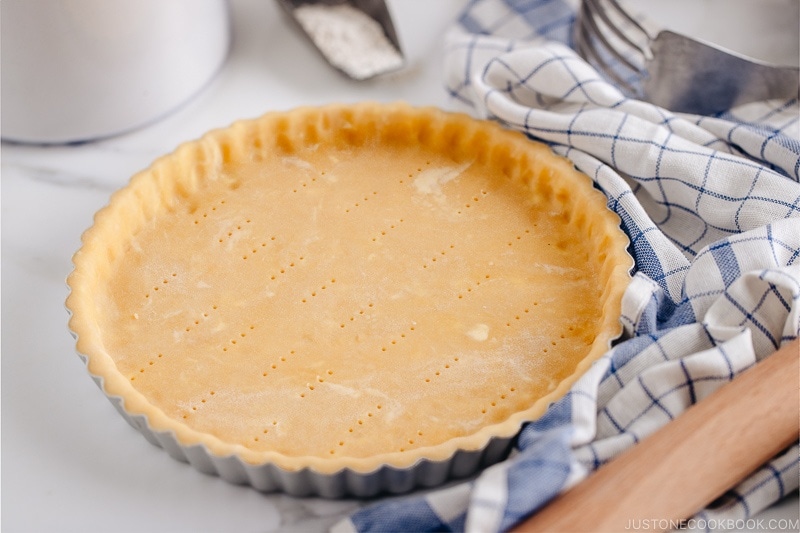Sweet Tart Crust
4.3
(30)
Your folders
Your folders
Prep Time: 20 minutes
Cook Time: 30 minutes
Total: 50 minutes
Servings: 1
Cost: $32.35 /serving
Author : Namiko Chen

Ingredients
Export 3 ingredients for grocery delivery
Instructions
Step 1
Gather all the ingredients. If possible, keep all ingredients chilled in the refrigerator until ready to start.
Step 2
Cut the butter into small cubes. Crack the egg into a small bowl.
Step 3
In a large bowl, stir together the flour, sugar, and salt.
Step 4
Add the butter to the flour mixture. Using a pastry cutter or 2 knives, cut the butter into flour mixture until the texture resembles coarse cornmeal, with butter pieces no larger than small peas.
Step 5
Add the egg and vanilla extract and mix with a fork just until the dough pulls together.
Step 6
Process all-purpose flour, sugar, and salt in a food processor for a few seconds until combined.
Step 7
Add the butter and pulse until mixture resembles coarse meal, about 15 pulses.
Step 8
Add the egg and vanilla extract and pulse until the dough forms clumps, about 15 seconds.
Step 9
Transfer the dough clumps to a lightly floured surface (I use this pastry mat) and form into a ball. If sticky, lightly sprinkle flour.
Step 10
Flatten the ball with your hands to form a thick disk. Wrap with plastic wrap and refrigerate for at least 1 hour (or 30 mins in the freezer). The dough must be completely chilled before being used. To store: If you don’t use the dough right away, you can store in the refrigerator for up to 3 days, or freeze it for up to 2 months. Thaw overnight in the refrigerator, then let sit at room temperature until easily rollable.
Step 11
Take the dough out from the refrigerator and let it sit on the counter for a few minutes to soften slightly for easy rolling. Meanwhile lightly butter a 9-inch (23 cm) fluted tart pan with a removable bottom.
Step 12
Lightly flour your working surface and place the dough on top. Using a rolling pin, roll out the dough into an 11-inch circle, with 1/8-inch (3 mm) thick. If the dough is too soft, put back into the refrigerator.
Step 13
Flour the rolling pin and roll the dough loosely around it, then unroll it into the tart pan.
Step 14
Evenly pat the dough onto the bottom and sides of the greased tart pan. Seal any cracks in the dough.
Step 15
Trim off excess dough with a sharp knife, or with the rolling pin by rolling over the tart pan. A good tip I learned from a Japanese cookbook (optional): Using your index finger, gently press the dough onto the side so the dough will peak out 2 mm from the pan. The dough tends to shrink while baking, so this helps to keep the height of the crust.
Step 16
With a fork, gently prick the dough several times. Cover the tart pan with plastic wrap and place in the freezer until firm, about 30 minutes. Freezing the dough before baking prevents it from shrinking.
Step 17
To prevent the crust from becoming soggy, I always like to blind bake the crust. Preheat the oven to 375 ºF (190 ºC) and place the rack in the center.
Step 18
When the oven is ready, tightly line the chilled crust with 2 layers of parchment paper, covering the edges to prevent them from burning. Fill the crust with pie weights (or dried beans, uncooked rice, pennies, etc). Make sure they are evenly distributed over the entire surface.
Step 19
Bake the crust for 20 minutes, until the foil no longer sticks to the dough. Transfer the crust to a wire rack and remove the pie weights and parchment paper.
Step 20
To partially bake the crust, continue to bake the crust for 5 minutes longer. Proceed with your tart recipe: add the filling and finish baking. Check your recipe to see if the crust should be used while warm or after it’s been left to cool on a wire rack.
Step 21
To fully bake the crust, bake for 10 minutes longer or until it is dry and the bottom turns lightly golden. Remove the crust from the oven and place on a wire rack to cool.
Step 22
The baked crust can be stored at room temperature or refrigerator for 2 days or frozen for 2 months. When ready to serve, let it thaw overnight in the refrigerator, then let sit at room temperature before filling and decorating.